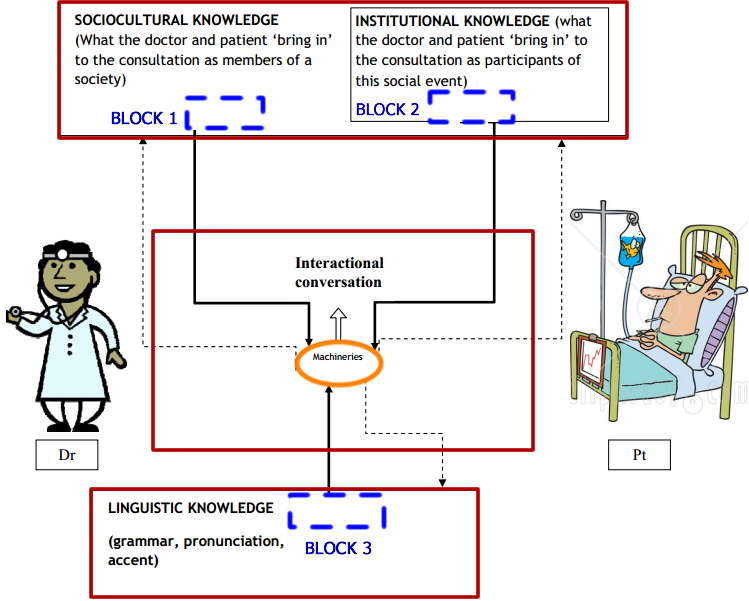3: Introduction to the Analytical Tool
3.1 Verbal interaction
This represents how the doctor and patient use the three building blocks (sociocultural knowledge, institutional knowledge and linguistic knowledge) to build their talk interactively. It represents the components of the interaction, including:
- components that pre-exist the interaction
- components that the doctor and patient jointly develop during the interaction.
The idea is that any clinical interaction – and any individual part of that interaction – can be understood in terms of this diagram. Each of these elements, and their impact on one another, is explained below. A conversation or, in our terms, an interaction is realised by speakers drawing on three types of pre-existing knowledge to talk with each other, namely:
- the sociocultural knowledge,
- institutional knowledge,
- linguistic knowledge.
The three types of knowledge are represented by the three big squares ![]() around the central square of ‘interactional conversation’. Institutional context is in effect part of the sociocultural context so the former is within the square of the latter. Speakers have so much knowledge that not all of it is relevant to one particular interaction.
around the central square of ‘interactional conversation’. Institutional context is in effect part of the sociocultural context so the former is within the square of the latter. Speakers have so much knowledge that not all of it is relevant to one particular interaction.
The dotted squares ![]() represent the relevant bits of knowledge used by speakers to build their interaction. The chosen knowledge is not brought into the interaction randomly but rather in a systematic manner, although such a system is often functioning at the unconscious level.
represent the relevant bits of knowledge used by speakers to build their interaction. The chosen knowledge is not brought into the interaction randomly but rather in a systematic manner, although such a system is often functioning at the unconscious level.
We call this system the interactional machinery, which is represented in ![]() the within the ‘interactional conversation’. represents the action of bringing knowledge into the interaction.
the within the ‘interactional conversation’. represents the action of bringing knowledge into the interaction.
The doctor and patient may bring in different types of knowledge into the interaction, through which they enrich or change their own knowledge. This is represented by ![]() .
.
